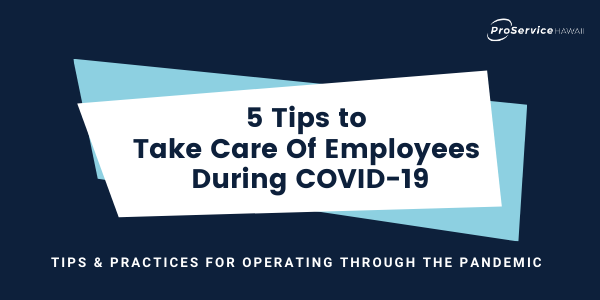Is it Time to Implement Remote Work for Your Employees?
After weeks of spreading across the mainland, COVID-19 has officially arrived in Hawaii, with cases on all islands. Many employers have already sent their workforce home to work remotely, while others may be wondering if it’s time to take that step, or whether it’s even possible for their business.
The decision to shift to remote work isn’t easy. Here’s what employers need to know.
- Social distancing can slow the spread of the disease: First and foremost, remember that the CDC is recommending Americans practice “social distancing” to slow the spread of coronavirus. This can help prevent our healthcare system from becoming overwhelmed, saving lives. So by having your employees work from home, you’re not only protecting their health, but the safety of our entire community.
- Many employees are ready for this: We live in a digital world, so working remotely is not new. Even if your employees haven’t officially worked from home before now, many people are already accustomed to interacting online, using digital tools, and learning new technology. Each business is unique, but chances are, making this transition might be easier than you think.
- How to determine if your employees can work remotely: Maybe you’ve determined that it’s time to pull the trigger on social distancing, and you want to send your employees home. What next? Here are four steps to follow for guidance as you work toward the transition:
Step 1: Identify the employee's core work
Look at your employee’s job, and make a list of the key responsibilities and tasks that they usually perform. “Core work” involves the activities that take up at least 70% of your employee’s usual work hours. If you’re not sure, talk with your employee about the day-to-day tasks that take up most of their time.
Step 2: Assess in-person requirements
Review the employee’s responsibilities, and identify any activities that require them to be physically on-site. For example, an accountant or admin may do a lot of tasks that could be handled over the phone or on the computer, like record-keeping, consulting with clients, or calling clients to remind them about appointments. Other roles can only be done in person, like cooking, stocking shelves, cleaning hotel rooms, or providing dental hygiene services.
If an employee’s job doesn’t involve a lot of tasks that have to be done in person, consider transitioning them to work from home. If you’re not sure, ask yourself:
- Does this employee interact with customers face-to-face regularly?
- Can the employee’s tasks be done by phone, or by using email to communicate with clients?
- What tasks, if any, would not get done if the employee was not physically on-site?
- Does this person have enough volume of work they can do at home to keep them busy for days or weeks?
- If the employee’s primary job can’t be done remotely, are there other tasks they could be assigned until business gets back to normal?
Step 3: Evaluate resources and access
Maybe you’ve determined that an employee doesn’t need to be physically in the office to do their core work. But do they have the right resources and access to do their job at home? Determine what tools the employee needs to do their job. For example:
- Desktop or laptop computer
- Internet access
- Secure access to applications and data
- Online communication and collaboration tools like Zoom or Google docs
- Home phone or cell phone with adequate data
Once the employee is set up to work from home, consider trying it out. Schedule a time for the employee to test the remote work experience and identify any problems. Make sure the employee’s manager is on hand to provide feedback, along with IT support to help with troubleshooting.
Step 4: When working from home isn't possible
In a perfect world, employees could transition seamlessly to their home office, where they would be healthy and productive until it’s safe to come back to work. But in reality, that may not always be possible. If you’re not able to assign remote work, or your business relies on in-person activity, like retail stores or health-care providers, there are still things you can do to reduce risk for your employees and customers. Consider these alternatives to provide more distance and minimize the risk of infection:
- Stagger shifts to have fewer people working side-by-side.
- Reduce your operating hours or shorten the lengths of shifts to limit potential exposure
- Look for ways to increase the physical space between employees and customers, such as using windows for interactions or implementing curbside drop-off and pickup.
- Limit the number of customers and employees in your workplace at any given time.
- Post signage at entrances asking people not to enter if they have symptoms, and suggesting they send a friend in instead.
- Provide staff with clear instructions and expectations around hygiene, such as using gloves, staying home if sick, and proper hand-washing.
Make the best decision for your employees and community
Following the news about coronavirus is stressful for everyone. Employers have the additional worry of trying to figure out how best to take care of their employees and customers in a rapidly changing situation. While making the decision to work from home isn’t easy, by staying calm and following a step-by-step process, you’ll be able to come up with the plan that’s best for everyone.
Want to get more practical advice on how to manage your business through COVID-19? Visit our Employer’s Guide to Coronavirus.








